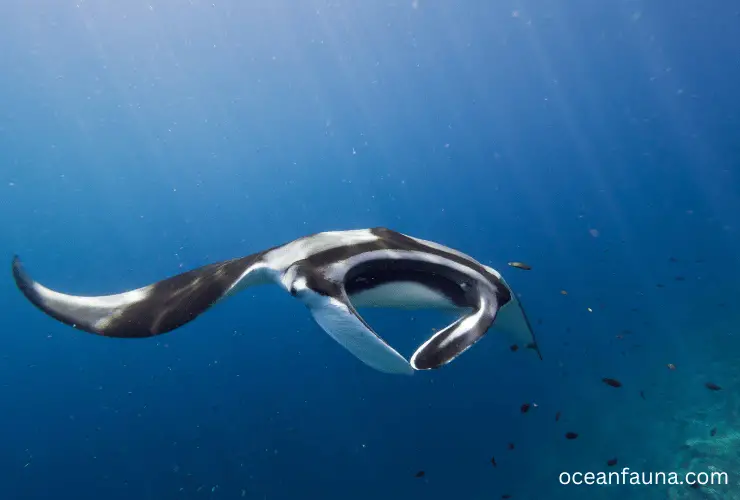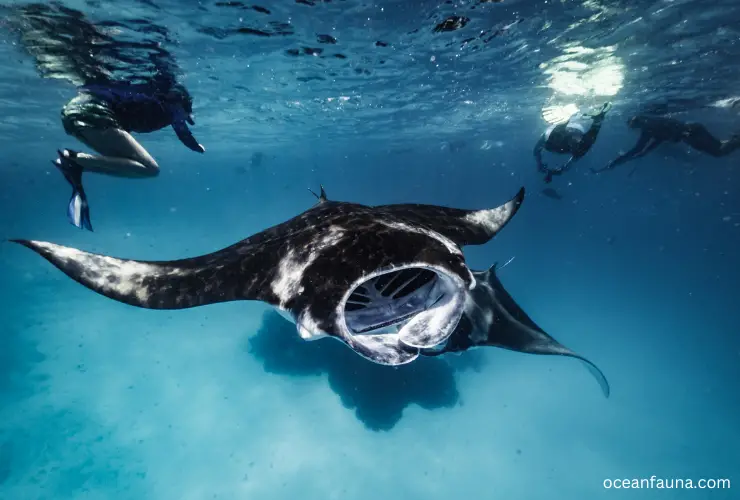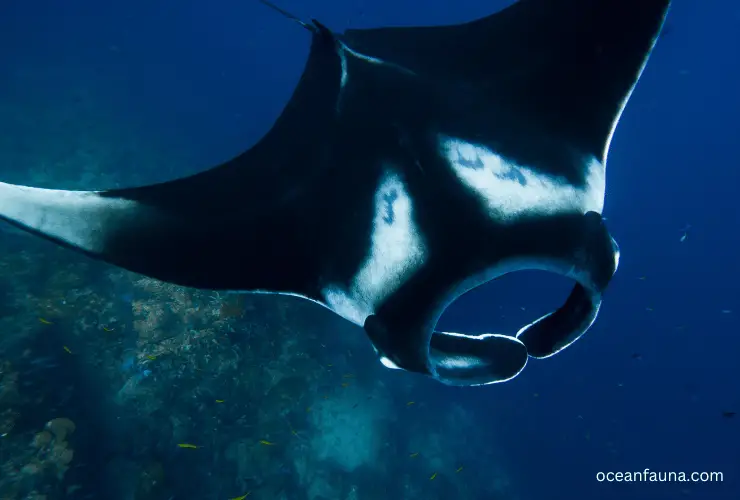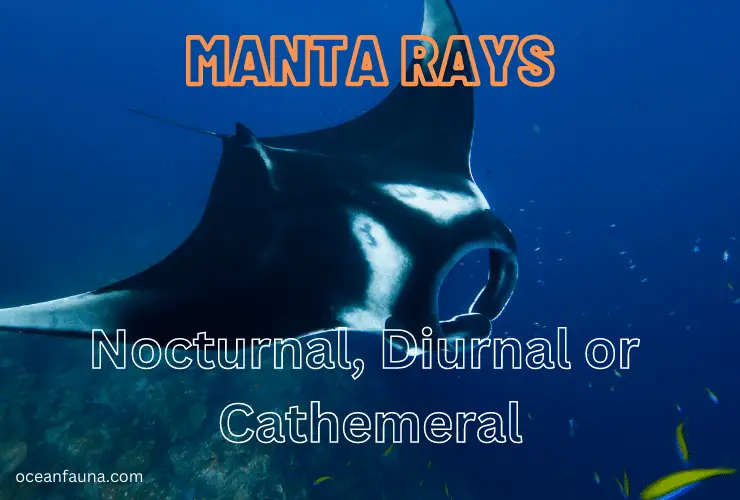Manta rays are categorized as cathemeral animals because they are neither strictly nocturnal nor diurnal. You will find them active both day and night, as opposed to nocturnal animals, which are only active at night.
This article will dive deep into the behavior and habits of these enigmatic creatures to bring light to this question. While feeding habits often indicate whether animals are nocturnal, there is more to be uncovered about Manta rays.
So, join me as I unlock the secrets behind their night-time activity, and explore the mysterious habits of Manta rays and if they genuinely have a nocturnal lifestyle.
Do Manta Rays Sleep?
Although there is not a lot of proof to say that manta rays sleep in the conventional sense, but they take breaks throughout the day and night.
The Manta Trust, an organization devoted to the preservation and study of manta rays, claims that they rest between the hours of day and night.

It’s clear that like humans or other mammals, they don’t sleep. Also, as a fish, they don’t have eyelids. So, experiencing REM sleep is indeed impossible. Rather, they go through a resting phase. The resting phase in their life cycle makes their brain less active.
Note: They have been seen to move slowly or hover for lengthy periods close to the ocean floor, which may indicate that they are resting.
Although they are resting, they can respond to their surroundings. It is said that they can survey the surrounding water with their eyes on their heads, even when half submerged in the sand or mud.
This might be relaxation or rest, as certain animals sleep with open eyes.
Are Manta Rays Nocturnal? Do They Come Out at Night?
In 2010, a study published in marine biology supported that they are not directly classified as nocturnal. They are referred to as cathemeral in nature. It’s proven that besides their activeness during the night, they are often found intersecting and feeding with each other during the day. This behavior is very common during mating season.

In more detail, if you search, it’s possible that you can discover further data about this fact.
Dr. Andrea Marshall stated that “yes, manta rays are not nocturnal or diurnal animals,” according to Dr. Marshall’s interview with National Geographic.
Note: Dr. Andrea Marshall, a renowned authority on manta rays and a co-founder of the Marine Megafauna Foundation.
They come out at night and hunt for their prey, usually plankton. When there is enough light, you can frequently see them feeding during the full moon.
Manta rays come out during the nighttime because plenty of food is available for them.
The reason why there is more food in the nighttime rather than during the daytime is that plankton is attracted to the light. The light can appear from people in the boats or anything else.
As the light attracts the plankton, they come out towards the light. In return, manta rays are attracted to the plankton, so they come out.
When it comes out of the water at night, the manta ray usually moves around on the surface until it finds prey. If no prey is in sight, it will swim near the surface until something approaches from below.
Why Are Manta Rays Active at Night?
There are a variety of explanations for why they are more active at night.
Here are two significant reasons
Avoiding predators
Even though manta rays have few potential predators, it is nonetheless possible for larger sharks and killer whales to attack them.
Yet, these majestic creatures counter this danger by being more active at night, when the risk of falling victim to an attack is reduced.
Reproduction
Manta rays assemble in large groups during their mating season, which can happen at any time of the year, depending on the area.
During this time, their activity level increases, with a preference for the nighttime hours.
Research suggests that increased activity at night helps promote courtship and mating interactions among the species during breeding.
What is the Best Time to See Manta Rays?
The best time to see manta rays that are too close would be at night during the hours of darkness, generally after sunset and before sunrise.

And if you want an exact time, it is preferably a few minutes after sunset and around 9 PM. However, the exact timing can vary depending on the location and season.
It’s best to check with local dive operators or research the location you plan to visit to determine the best time to see manta rays at night.
It’s also important to note that while manta rays are attracted to lights, it’s essential to approach and observe them responsibly to avoid disturbing or harming them.
Following local guidelines and regulations and seeking experienced professionals’ guidance when encountering manta rays at night are important.
FAQs
Can you see manta rays in the daytime?
Yes, Manta rays can be seen during the daytime. They can be seen swimming, eating and interacting with other marine creatures during the day.
In fact, the daytime provides some of the best opportunities to see manta rays since the sun is out, the water is clear, and it is easier to recognize them.
Do Manta Rays Glow in The Dark?
Manta rays do not shine at night. They lack bioluminescence, the capacity for some living things to produce light through a chemical process.
There is no proof that manta rays possess the bioluminescence that several marine organisms have, including some fish species, jellyfish, and plankton.
Manta rays, however, may reflect or absorb ambient light, increasing their visibility or giving them the appearance of glowing at night.
They also have some little white spots on their bellies, which may reflect moonlight or other nighttime light sources in the water.
Moreover, divers and snorkelers may observe manta rays at night using artificial lights, which might give the appearance that the creatures are glowing.
All of the information mentioned above can explain why manta rays sometimes glow in the dark and why they glow at the source.
Conclusion
According to the scientific literature “Biogeography of time partitioning in mammals,”__
“Species that stay active mostly during the day or mostly at night are called cathemeral species. Globally, you will find 8.5% cathemeral animals” ~by Jonathan J. Bennie, James P. Duffy, Richard Inger, and Kevin J. Gaston.
Among 8.5% of cathemeral animals, manta rays are one of the significant species. If you analyze the ancestral characteristics of both manta rays and nocturnal animals, you will find some species engaging in night-time feeding.
The manta rays in Kona, Hawaii, are the only ones that engage in night-time feeding and perform barrel rolls in close proximity to humans when they feed at night.
This behavior has been passed down from one special manta ray, a female called Lefty. It was seen feeding on the phytoplankton that gathered in the floodlight from a nearby Sheraton hotel back in 1979.


1 thought on “Are Manta Rays Nocturnal? [Explained]”